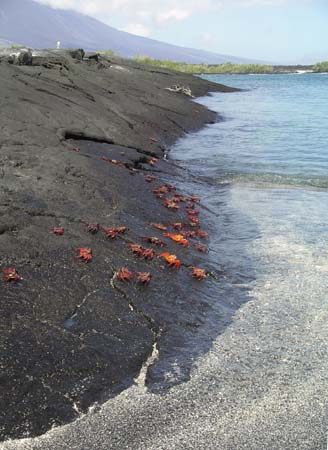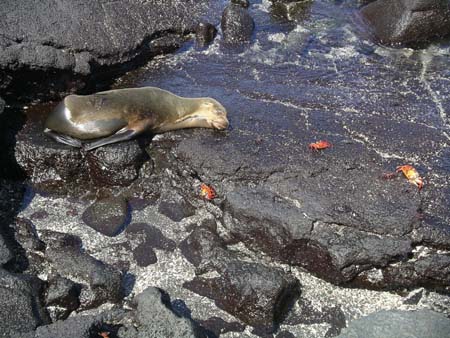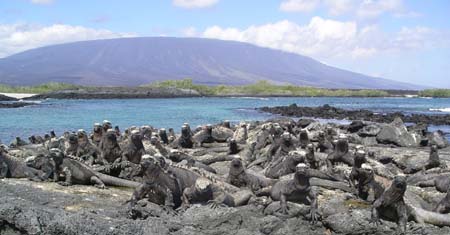Monday, April 26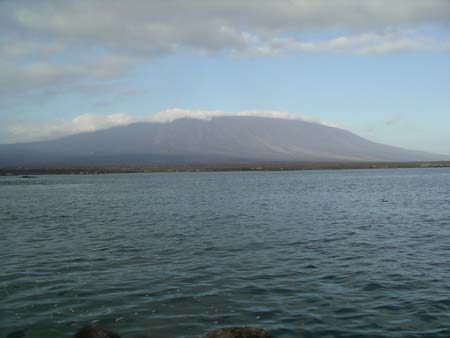
Paula: Our ship cruised west during the night, bringing us to the shore of Fernandina Island. The plan for today included time on Fernandina and the nearby Isabela island, including hiking, snorkeling, and dinghy rides.
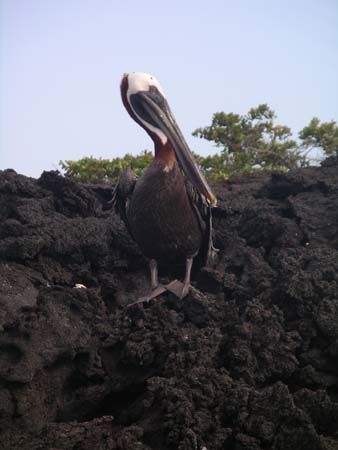 We
started with a dinghy exploration around the coastline of Fernandina early
this morning, observing the wildlife and admiring the beautiful scenery. Fernandina
is the youngest and westernmost island in the archipelago. This is also one
of the few islands where Charles Darwin actually landed on in 1835.
We
started with a dinghy exploration around the coastline of Fernandina early
this morning, observing the wildlife and admiring the beautiful scenery. Fernandina
is the youngest and westernmost island in the archipelago. This is also one
of the few islands where Charles Darwin actually landed on in 1835.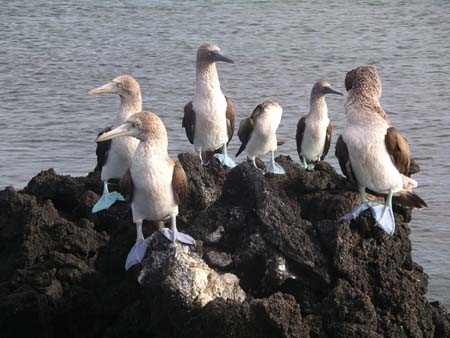
In the distance we observed Isabela, the largest island in the Galapagos with its six volcanoes. The volcanoes on these islands are considered the most active because they sit over a geological "hot spot." Along the shoreline we enjoyed seeing blue footed boobies, brown pelicans, sea lions, a blue heron, several storm petrel, a few penguins and our first flightless cormorant.
We then began a hike at Punta Espinosa on the northeast coast of Fernandina
Island. After walking briefly through a mangrove forest (these trees are important
because they prevent erosion of the coastline), we found ourselves walking
on large areas of cooled lava. Fernandina Volcano is considered the 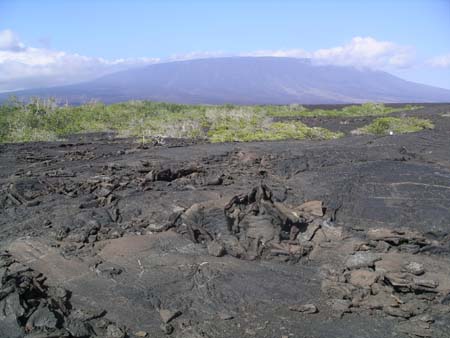 most
active in all of the Galapagos, and it last erupted in 1995. We walked along
the lava flows for the entire hike, being careful not to
most
active in all of the Galapagos, and it last erupted in 1995. We walked along
the lava flows for the entire hike, being careful not to 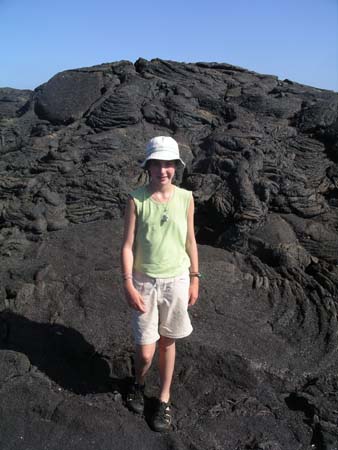 step
into the areas of sand which we learned contained buried marine iguana eggs.
The views were beautiful, as we hugged the shore and looked out toward Isabela
and its several volcanoes.
step
into the areas of sand which we learned contained buried marine iguana eggs.
The views were beautiful, as we hugged the shore and looked out toward Isabela
and its several volcanoes.
Fernandina is home to a large concentration of lava cactus, considered a
"pioneer plants" because it established the groundwork for the development
of 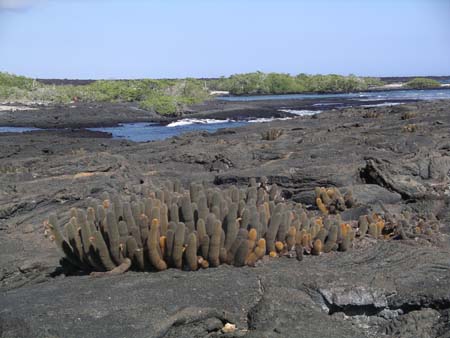 future
life forms on the Galapagos Islands including plants, bushes, trees and even
animals.
future
life forms on the Galapagos Islands including plants, bushes, trees and even
animals.
At one point during our walk, we heard sea lions barking from within a group
of mangrove trees. We walked toward the 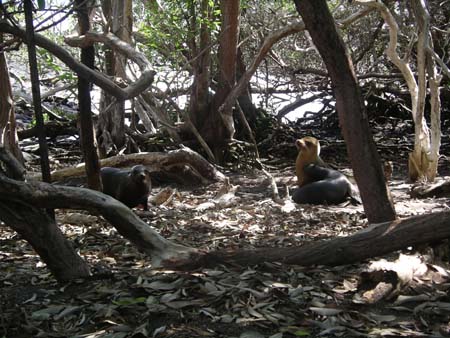 sounds
and found a cute family of very curious sea lions walking about in the shade
of the trees. It was strange to see sea lions in an area that looked like
a forest. One particular juvenile immediately walked over to us, and we took
several close-up
sounds
and found a cute family of very curious sea lions walking about in the shade
of the trees. It was strange to see sea lions in an area that looked like
a forest. One particular juvenile immediately walked over to us, and we took
several close-up 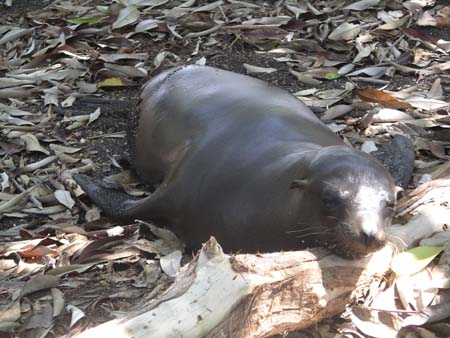 pictures
of him as he investigated the strange visitors who had ventured into his habitat.
Steve got right next to him, and David took a picture just as the sea lion
reached out as if to smell (or kiss?) Steve's arm.
pictures
of him as he investigated the strange visitors who had ventured into his habitat.
Steve got right next to him, and David took a picture just as the sea lion
reached out as if to smell (or kiss?) Steve's arm. 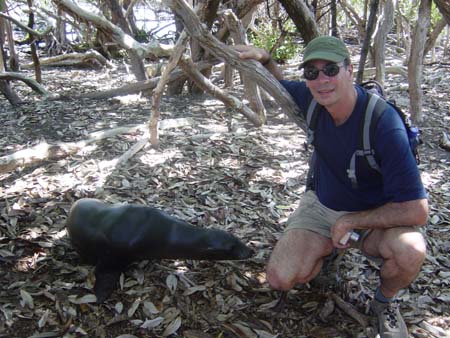
At the end of our hike, we stopped at a spot with the largest congregations
of marine iguanas that we have seen yet. This was really very special. These
are some of the largest iguanas anywhere in the Galapagos, and it was great
to see them all basking in the warm air. The iguanas all face directly into
the sun, 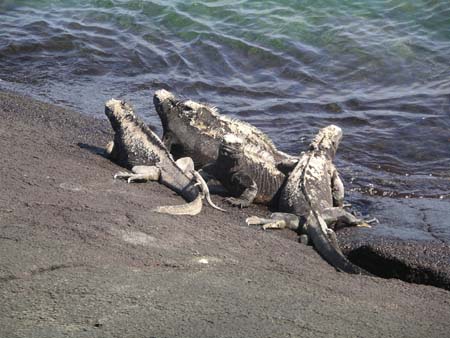 literally
heating their bodies in preparation for swimming in the cold waters in search
of food (they eat algae). This behavior makes for some great photographs,
since the iguanas all appear to be looking with their prehistoric faces directly
into the camera. We also were able to get quite close to them for pictures.
literally
heating their bodies in preparation for swimming in the cold waters in search
of food (they eat algae). This behavior makes for some great photographs,
since the iguanas all appear to be looking with their prehistoric faces directly
into the camera. We also were able to get quite close to them for pictures.
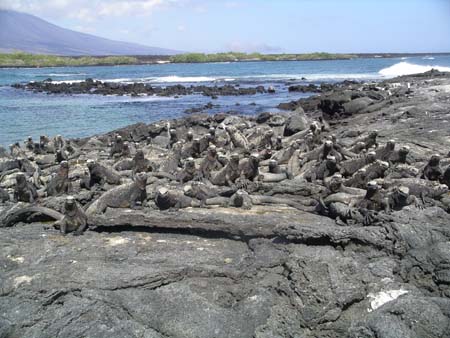

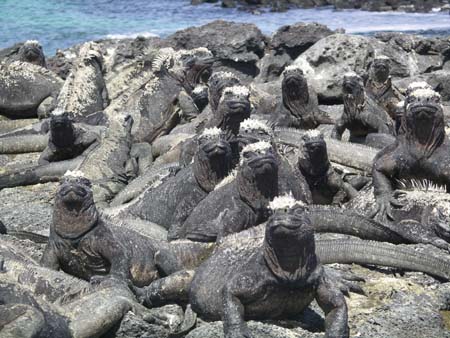
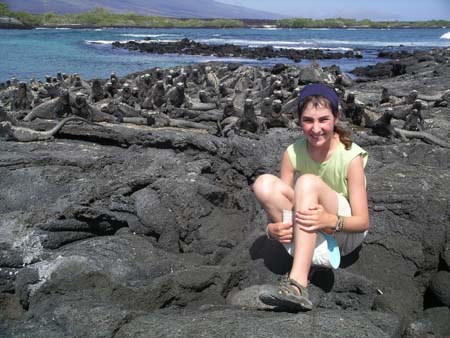
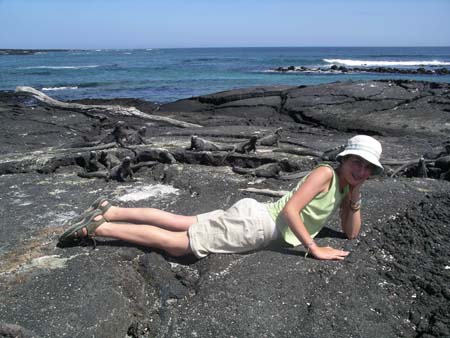
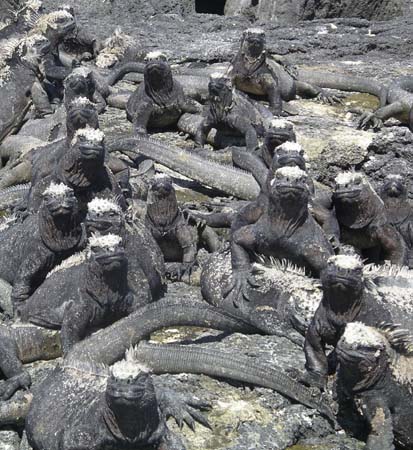
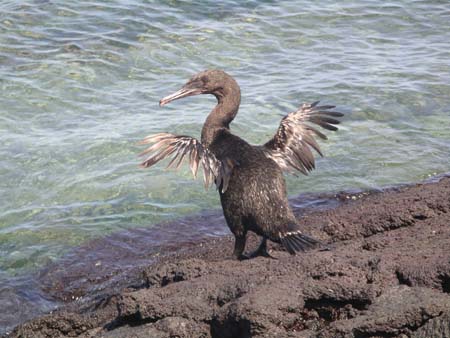
We also spent time observing the flightless cormorants drying their stubby wings in the sun. Our naturalist explained that the flightless cormorant is endemic to the Galapagos, and that this bird provides a rare opportunity to witness evolution in action. Of the 29 species of cormorants around the world, only this one does not fly. There are many theories about how this bird evolved and why, but many believe the flightless cormorant is the best example of Darwin's theory on natural selection and evolution. It seems quite plausible that because there are few predators on land and an abundant food source just off the coastline, that these birds over time lost their ability to fly in order to become more effective swimmers. These birds are breeding at present and we saw several pairs "snake necking" as apart of their courtship.
Land Iguanas also live on this island but over the past century have moved their habitat further inland for protection. Apparently, these iguanas, like the turtles and tortoises, were hunted almost to extinction by various explorers and pirates.
In the afternoon, we deep sea snorkeled off the coast of Isabela. The rough waters made it very difficult to see many fish, and the very cold waters had us back in the boat after only a short time. Despite this, we still managed to observe a penguin, several sea lions and two smaller sea turtles. In fact, one sea lion appeared to escort us along the rugged cliffs, helping us avoid an outcropping of volcanic rock. We considered ourselves brave to get in the rough, cold seas today especially since our naturalists told us that many sharks roam these cooler waters and that it is not uncommon to see hammerhead sharks when snorkeling here. After we were all back on the boat, we speculated about the sharks, guessing that although we didn't see them, they probably saw us!
Katie and I ended the day with a beautiful dinghy ride along these same cliffs. The dinghy handled the large ocean swells without difficulty and we were able to enjoy the abundant sea life from the safety of the boat. Flocks of boobies hung in large formations across the sky and landed on the cliffs. We also saw several more penguins and sea turtles. We had heard that the frigate birds often steal food from the boobies, and we in fact witnessed this thievery first-hand this afternoon.
This evening we will be crossing the equator line again in route to Seymour Island. Tomorrow we'll be hiking and snorkeling on Seymour, and then traveling to the highlands of Santa Cruz to hopefully observe the Galapagos tortoise in the wild.
